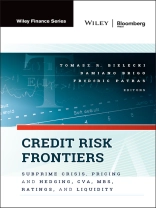A timely guide to understanding and implementing credit
derivatives
Credit derivatives are here to stay and will continue to play a
role in finance in the future. But what will that role be? What
issues and challenges should be addressed? And what lessons can be
learned from the credit mess?
Credit Risk Frontiers offers answers to these and other
questions by presenting the latest research in this field and
addressing important issues exposed by the financial crisis. It
covers this subject from a real world perspective, tackling issues
such as liquidity, poor data, and credit spreads, as well as the
latest innovations in portfolio products and hedging and risk
management techniques.
* Provides a coherent presentation of recent advances in the
theory and practice of credit derivatives
* Takes into account the new products and risk requirements of a
post financial crisis world
* Contains information regarding various aspects of the credit
derivative market as well as cutting edge research regarding those
aspects
If you want to gain a better understanding of how credit
derivatives can help your trading or investing endeavors, then
Credit Risk Frontiers is a book you need to read.
Tabela de Conteúdo
Foreword ix
Greg M. Gupton
Introduction 1
Tomasz R. Bielecki, Damiano Brigo, and Frédéric Patras
Part I: Expert Views
Chapter 1 Origins of the Crisis and Suggestions for Further Research 7
Jean-Pierre Lardy
Chapter 2 Quantitative Finance: Friend or Foe? 19
Benjamin Herzog and Julien Turc
Part II: Credit Derivatives: Methods
Chapter 3 An Introduction to Multiname Modeling in Credit Risk 35
Aurélien Alfonsi
Chapter 4 A Simple Dynamic Model for Pricing and Hedging Heterogeneous CDOs 71
Andrei V. Lopatin
Chapter 5 Modeling Heterogeneity of Credit Portfolios: A Top-Down Approach 105
Igor Halperin
Chapter 6 Dynamic Hedging of Synthetic CDO Tranches: Bridging the Gap between Theory and Practice 149
Areski Cousin and Jean-Paul Laurent
Chapter 7 Filtering and Incomplete Information in Credit Risk 185
Rüdiger Frey and Thorsten Schmidt
Chapter 8 Options on Credit Default Swaps and Credit Default Indexes 219
Marek Rutkowski
Part III: Credit Derivatives: Products
Chapter 9 Valuation of Structured Finance Products with Implied Factor Models 283
Jovan Nedeljkovic, Dan Rosen, and David Saunders
Chapter 10 Toward Market-Implied Valuations of Cash-Flow CLO Structures 319
Philippos Papadopoulos
Chapter 11 Analysis of Mortgage-Backed Securities: Before and After the Credit Crisis 345
Harvey J. Stein, Alexander L. Belikoff, Kirill Levin, and Xusheng Tian
Part IV: Counterparty Risk Pricing and Credit Valuation Adjustment
Chapter 12 CVA Computation for Counterparty Risk Assessment in Credit Portfolios 397
Samson Assefa, Tomasz R.Bielecki, Stéphane Crépey, and Monique Jeanblanc
Chapter 13 Structural Counterparty Risk Valuation for Credit Default Swaps 437
Christophette Blanchet-Scalliet and Frédéric Patras
Chapter 14 Credit Calibration with Structural Models and Equity Return Swap Valuation under Counterparty Risk 457
Damiano Brigo, Massimo Morini, and Marco Tarenghi
Chapter 15 Counterparty Valuation Adjustments 485
Harvey J. Stein and Kin Pong Lee
Chapter 16 Counterparty Risk Management and Valuation 507
Michael Pykhtin
Part V: Equity to Credit
Chapter 17 Pricing and Hedging with Equity-Credit Models 539
Benjamin Herzog and Julien Turc
Chapter 18 Unified Credit-Equity Modeling 553
Vadim Linetsky and Rafael Mendoza-Arriaga
Part VI: Miscellanea: Liquidity, Ratings, Risk Contributions, and Simulation
Chapter 19 Liquidity Modeling for Credit Default Swaps: An Overview 587
Damiano Brigo, Mirela Predescu, and Agostino Capponi
Chapter 20 Stressing Rating Criteria Allowing for Default Clustering: The CPDO Case 619
Roberto Torresetti and Andrea Pallavicini
Chapter 21 Interacting Path Systems for Credit Risk 649
Pierre Del Moral and Frédéric Patras
Chapter 22 Credit Risk Contributions 675
Dan Rosen and David Saunders
Conclusion 721
Tomasz R. Bielecki, Damiano Brigo, and Frédéric Patras
Further Reading 725
About the Contributors 727
Index 729
Sobre o autor
TOMASZ R. BIELECKI is a Professor of Applied Mathematics at the Illinois Institute of Technology. He is the author of numerous research papers in the areas of stochastic analysis, stochastic control, manufacturing systems, operations research, and mathematical finance. Bielecki is a coauthor of the monographs Credit Risk: Modeling, Valuation and Hedging and Credit Risk Modeling. He has been a recipient of various research grants and awards and consults for various financial companies.
DAMIANO BRIGO was recently appointed as Gilbart Professor of Financial Mathematics at King’s College, London, heading the research of the mathematical finance group. He has published more than fifty works in top journals on mathematical finance, systems theory, probability, and statistics; a book for Springer-Verlag that has become a field reference in stochastic interest rate modeling; and a book for Wiley on credit models and the crisis. Brigo obtained a Ph D in stochastic filtering with differential geometry in 1996 from the Free University of Amsterdam.
FRÉDÉRIC PATRAS is Director of Research at the Centre National de la Recherche Scientifique (Université de Nice, France) and head of quantitative analysis at Zeliade Systems, a software and service provider for financial institutions. He studied at the École Normale Supérieure (Paris) and obtained a Ph D in mathematics at the Université Paris 7-Denis Diderot. He has authored more than thirty research papers in combinatorics, mathematical physics, probability, statistics, and mathematical finance.












